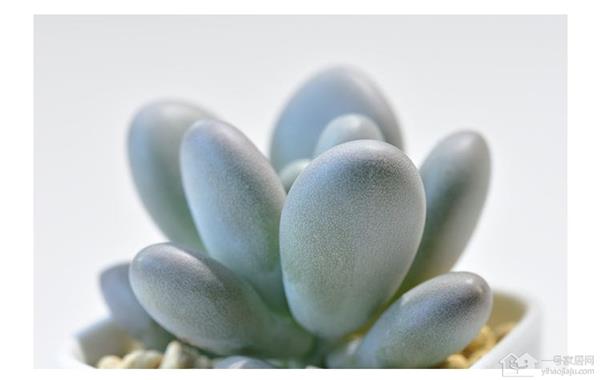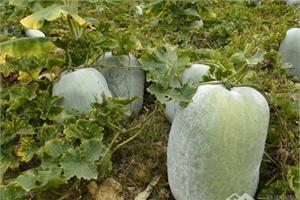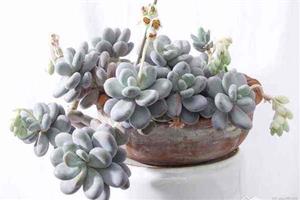The star beauty with super ornamental value how to cultivate and teach you to raise succulent plants.
Star beauty, can also be called thick-leaf grass, white beauty, is a kind of succulent plant, similar to the appearance of rainbow jade, is a common ornamental plant, its flowers are generally in full bloom in early summer, with a certain ornamental performance, usually can be planted on the balcony, windowsill or placed on the case table is a good choice. Star beauty is indeed a good desktop decoration. Next, I would like to introduce pictures of star beauty to ensure that you can tell who is "beauty" at a glance.

First, the morphological characteristics of star beauty
Stem part
The plant has an erect short stem at the initial stage of growth, and at the later stage the stem creeps to droop, up to 20 cm long and 0.7-1.3 cm wide in diameter.
Leaf blade
Fleshy leaves alternate, arranged in an extended rosette, Obovate to Obovate-elliptic, 3-5 cm long, 1.8-3 cm wide, 0.8-1.7 cm thick, apex obtuse, smooth surface, leaves ranging from bluish gray-green to lavender, covered with thick white powder.
Flower
Sepals are about 1.3-2.3 cm long and 1.0-1.6 mm wide. The petals are oval, 0.7-1.0 cm long and 0.3-0.45 cm wide, ranging from purplish red to red. Lobes erect. Anthers yellowish.
Plant type
The diameter of the whole plant can reach 6-10 cm, each plant has about 12-25 leaves, and the plant type is compact under normal growth condition.
Second, the growth habits of Xingmei
Like warm, dry and sufficient light environment, strong drought resistance, requires loose texture, good drainage of sandy loam. It grows well in warm winter and cool summer climate, and is not resistant to hot and humid weather in summer.
It is a tropical sunny and drought-tolerant plant, slightly resistant to semi-shade and not cold, suitable for growing in a sunny and cool and dry environment, avoiding dampness and muggy heat. The lowest temperature in winter should be above 10 degrees. Require well drained soil, sand and small particles of stone mixed soil is appropriate.
III. Types of star beauties
At present, the common types of star beauties are Qingxing Beauty, Ji Xing Beauty, Big Ji Xing Beauty, Little Jixing Beauty and so on.
Green star beauty: the green star beauty is a succulent plant of crassulaceae and thick-leaf grass, which is native to the state of San Luis Potosi in central Mexico. The leaves of the plant are arranged in ring shape, spatulate, with leaf tip, leaf margin arc-shaped, leaf hypertrophy, smooth trace white powder, grass green to dark green. Sunny leaves closely arranged edges and tips will turn red, weak light leaves will be light green, leaves become narrow and long, and the spacing between leaves will be overgrown.
Ji Xing Beauty: a small succulent plant or succulent plant of the genus Sedum of the family Sedum. The place of origin is located in the arid areas of West Asia and North Africa. Jixing Beauty is a perennial succulent plant with a height of 5-10 cm, with branched stems, inflated leaves, Obovoid, 2 cm long, green, fleshy leaves, dark green, like jadeite dark green fleshy leaves are very bright and beautiful in the sun. Blooming in spring, the flowers are light pink and white.
Fourth, how to raise the star beauty
Temperature: Xingmei is naturally fond of warm, dry and ventilated environment, which requires keeping cool temperature environment in summer and warm environment in winter. Only after meeting these conditions, Xingmei can grow well.
Soil: Xingmei's demand for soil is not high, but as long as its soil is loose and drained, its soil can be mixed with 1:1:1 peat, perlite and cinder, and its surface can be covered with river sand to prove its air permeability.
Lighting: star beauty loves sunlight, so it is necessary to give star beauty proper illumination, but in summer, star beauty should not accept direct sunlight and can be placed in a ventilated and shady place to receive astigmatism properly. Put the star beauty on the balcony in winter.
Watering: Xingmei's requirement for water is not very high, it can be watered almost 3-4 times a month in summer, watering can be reduced appropriately when the temperature is low in winter, and watering can be carried out gradually in spring, otherwise it is easy to cause rotten roots.
The above is the relevant introduction of this article, I believe you have a simple understanding of this after reading it, if necessary, you can continue to pay attention to the No. 1 home network for more information.
Related
- Wuhan Hospital Iron Tree Blooming Result Was Instantly Frightened by the Gardener Master
- Which variety of camellia is the most fragrant and best? Which one do you like best?
- What is the small blue coat, the breeding methods and matters needing attention of the succulent plant
- Dormancy time and maintenance management of succulent plants during dormancy
- Minas succulent how to raise, Minas succulent plant pictures
- What are the varieties of winter succulent plants
- How to raise succulent plants in twelve rolls? let's take a look at some experience of breeding twelve rolls.
- Attention should be paid to water control for succulent plants during dormant period (winter and summer)
- Watering experience of twelve rolls of succulent plants
- Techniques for fertilizing succulent plants. An article will let you know how to fertilize succulent plants.



